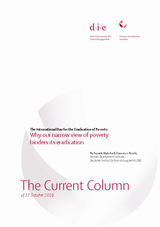The International Day for the Eradication of Poverty
Why our narrow view of poverty hinders its eradication
Malerba, Daniele / Francesco BurchiThe Current Column (2019)
Bonn: German Development Institute / Deutsches Institut für Entwicklungspolitik (DIE), (The Current Column of 17 October 2019)
Bonn, 17 October 2019. On the 17th of October 1987 a call to action led by Father Joseph Wresinski gathered about 100,000 people in Paris to forcefully claim that poverty is a violation of Human Rights. Inspired by this monumental event, in 1992 the UN officially declared this date as the International Day for the Eradication of Poverty. Today, more than three decades after the Paris event, poverty eradication is still regarded as “the greatest global challenge”, as stressed at the recent UN High-level Political Forum (HLPF) on Sustainable Development. As the last decades have shown a significant reduction in extreme poverty, this may seem like an overstatement. In 1990, more than a third of the global population lived in extreme poverty (defined by the World Bank as having an income below 1.90 USD per day). In 2015, this value decreased to one out of ten. So far, great news. Yet a recent slowdown in global poverty alleviation justifies why poverty reduction should remain high on the agenda: As a consequence of this slowdown, the world is likely to miss the target of ending poverty by 2030, especially if the projected negative consequence of climate change on poverty materialises. To reverse this trend, a better understanding of poverty is needed. Both the Sustainable Development Goal (SDG) 1 and the International Day for the Eradication of Poverty call to end destitution and poverty in all their forms everywhere. This commitment has two main implications. First, it is necessary to go beyond a conceptualization of poverty based on income scarcity to fully acknowledge the multidimensional nature of poverty; this means assessing poverty as a lack of adequate education, health, decent employment, and other important dimensions of people’s lives. In a recent study we showed that the levels of multidimensional poverty are much higher than those of income poverty. Furthermore, between 2000 and 2012 the decline in multidimensional poverty was substantially lower than that of income poverty. Second, for both income and multidimensional poverty, the success in reducing poverty has varied greatly across geographical areas. Global poverty reduction has been driven by China and other countries in East Asia. Some regions have registered very limited improvements. The absolute number of people living in extreme poverty in sub-Saharan Africa is even on the rise. 85 percent of its population live with a daily income lower than the price of a cup of coffee in New York. At the same time, rural areas in low- and middle-income countries are being neglected by national governments. Their levels of poverty are on average about three to four times higher than in urban areas. These developments show that business as usual will not eradicate poverty in all its forms everywhere. Policy-makers need to adopt different strategies. While economic growth remains important through the creation of resources and jobs, relying heavily on it is neither sufficient nor environmentally sustainable. Addressing poverty rather requires social policies, and in particular social protection schemes. The experience of large-scale programmes, in particular cash transfers in Latin America, indicates that such mechanisms could be very effective in assuring that no one is left behind. They successfully reduce inequality as well as both income and multidimensional poverty. The number of programmes and their coverage have rapidly expanded also in Asia. The situation in sub-Saharan Africa, however, is very different, as highlighted by a recent report by UNDP, which partially explains the persistence of poverty in the region. Despite the fact that the right to social protection is mentioned in a growing number of constitutions and despite the increasing number of social programmes, it is estimated that 87 percent of the population in sub-Saharan Africa is without any social protection cash benefits. Father Joseph Wresinski, who died in 1988, would certainly be pleased of the global progress in poverty reduction since the rally in Paris. However, his call to action should remain vividly etched in the minds of policy-makers if we want to end poverty for good. In this respect, while the last UN HLPF meeting focused on the urgent climate crisis, poverty eradication needs to remain central in the international agenda, focusing on its synergies with climate change mitigation measures. Policy efforts need to prioritise sub-Saharan Africa, where poverty has remained substantially unchanged, and rural areas, which are still discriminated in terms of allocation of national resources. Social protection schemes offer a potentially viable solution, but there is a need to increase government ownership of these programmes and their quality. Finally, research can play an important role especially by developing improved measures of poverty. Only by better understanding who the poor are, where they live and what the root causes are, we can identify more effective policies and eradicate poverty once and for all.



